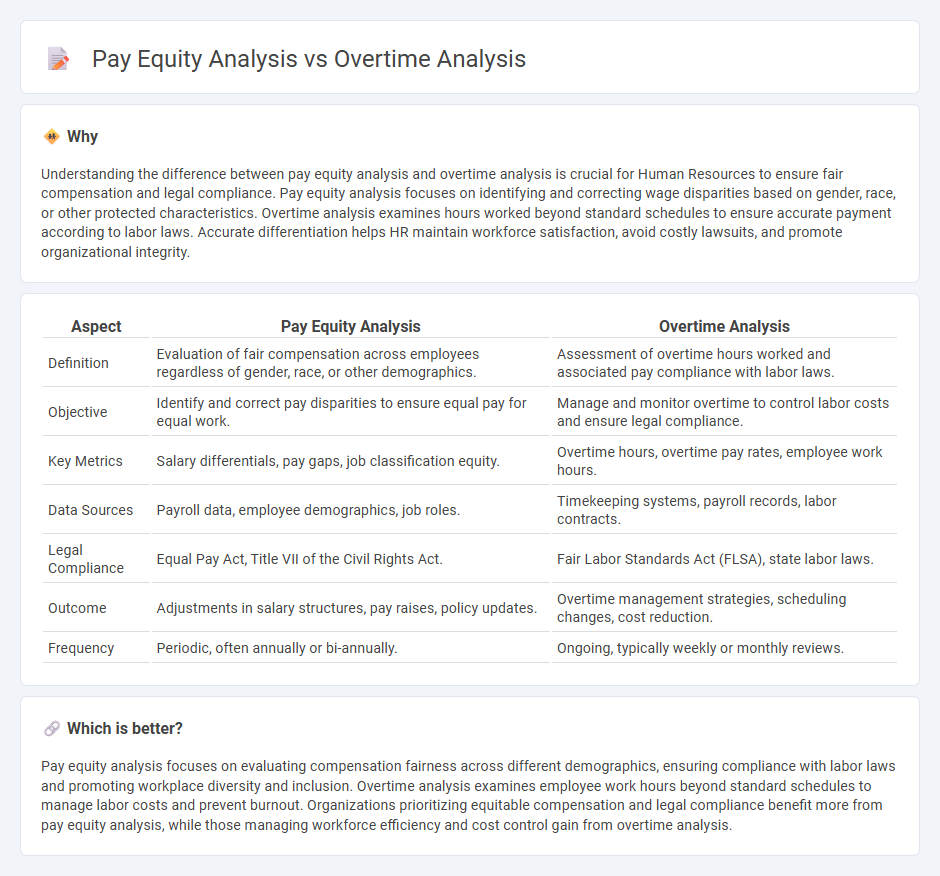
Pay equity analysis examines the fairness of compensation across employees, focusing on eliminating wage disparities based on gender, race, or other demographic factors to promote inclusivity and compliance with labor laws. Overtime analysis investigates the patterns and costs associated with extra working hours, aiming to optimize workforce productivity while managing labor expenses under regulatory guidelines. Explore our detailed breakdowns to understand how these analyses impact organizational efficiency and employee satisfaction.
Why it is important
Understanding the difference between pay equity analysis and overtime analysis is crucial for Human Resources to ensure fair compensation and legal compliance. Pay equity analysis focuses on identifying and correcting wage disparities based on gender, race, or other protected characteristics. Overtime analysis examines hours worked beyond standard schedules to ensure accurate payment according to labor laws. Accurate differentiation helps HR maintain workforce satisfaction, avoid costly lawsuits, and promote organizational integrity.
Comparison Table
| Aspect | Pay Equity Analysis | Overtime Analysis |
|---|---|---|
| Definition | Evaluation of fair compensation across employees regardless of gender, race, or other demographics. | Assessment of overtime hours worked and associated pay compliance with labor laws. |
| Objective | Identify and correct pay disparities to ensure equal pay for equal work. | Manage and monitor overtime to control labor costs and ensure legal compliance. |
| Key Metrics | Salary differentials, pay gaps, job classification equity. | Overtime hours, overtime pay rates, employee work hours. |
| Data Sources | Payroll data, employee demographics, job roles. | Timekeeping systems, payroll records, labor contracts. |
| Legal Compliance | Equal Pay Act, Title VII of the Civil Rights Act. | Fair Labor Standards Act (FLSA), state labor laws. |
| Outcome | Adjustments in salary structures, pay raises, policy updates. | Overtime management strategies, scheduling changes, cost reduction. |
| Frequency | Periodic, often annually or bi-annually. | Ongoing, typically weekly or monthly reviews. |
Which is better?
Pay equity analysis focuses on evaluating compensation fairness across different demographics, ensuring compliance with labor laws and promoting workplace diversity and inclusion. Overtime analysis examines employee work hours beyond standard schedules to manage labor costs and prevent burnout. Organizations prioritizing equitable compensation and legal compliance benefit more from pay equity analysis, while those managing workforce efficiency and cost control gain from overtime analysis.
Connection
Pay equity analysis and overtime analysis are interconnected through their shared focus on compensation fairness and compliance with labor laws. Pay equity analysis ensures that employees receive equal pay for equal work regardless of gender or other protected characteristics, while overtime analysis verifies that non-exempt employees are compensated appropriately for hours worked beyond standard schedules. Together, these analyses help organizations identify and correct pay disparities, prevent wage violations, and promote transparent, equitable payroll practices.
Key Terms
**Overtime Analysis:**
Overtime analysis examines employee work hours exceeding standard limits to identify patterns affecting labor costs and operational efficiency. It highlights disparities in overtime distribution that may signal workload imbalances or potential compliance issues under labor laws. Explore how strategic overtime analysis can optimize workforce management and ensure fair compensation practices.
Hours Worked
Overtime analysis centers on tracking and evaluating hours worked beyond standard schedules to ensure compliance with labor laws and manage payroll costs effectively. Pay equity analysis examines whether employees receive fair compensation relative to their hours worked, job roles, and qualifications, addressing disparities across gender and demographic groups. Explore detailed methodologies and best practices for balancing overtime management with pay equity to optimize workforce fairness and productivity.
Overtime Rate
Overtime analysis primarily examines the Overtime Rate, identifying trends in hours worked beyond standard shifts to manage labor costs and productivity. Pay equity analysis assesses fairness in compensation across demographics, ensuring overtime pay practices align with non-discriminatory wage policies. Explore deeper insights into Overtime Rate impacts on pay equity to optimize workforce management strategies.
Source and External Links
Mastering Overtime Cost Analysis with Excel on Steroids - Overtime cost analysis evaluates the financial impact of employees working beyond regular hours to determine cost-effectiveness, budgeting, compliance, and productivity implications, highlighting that excessive overtime can increase turnover and operational strain.
Good vs Bad Overtime: What It Is & How to Benchmark It - Quality of overtime is assessed by comparing revenue per hour to cost per hour, distinguishing 'good overtime' where extra hours increase revenue proportionally from 'bad overtime' where costs grow faster than revenue, signaling inefficiencies.
7 Best Practices For Analyzing And Managing Overtime - Effective overtime management includes practices like forecasting workforce demand, establishing formal policies, performing cost-benefit analyses, and understanding root causes to reduce unnecessary overtime and optimize labor costs.
 dowidth.com
dowidth.com